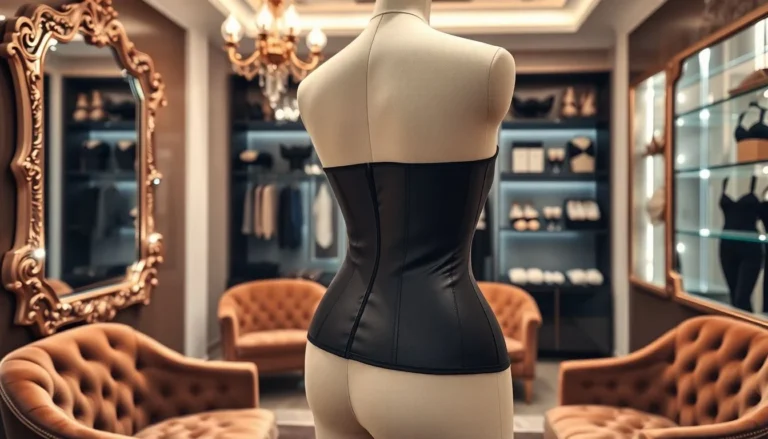In recent years, waist trainers have become a hot trend in both fitness and fashion scenes. More people are turning to them to help create that sleek, hourglass shape. Not only can they boost confidence, but they also improve posture and provide core support. However, many worry about safety or whether waist training really works. Picking the right waist trainer is key to getting results without risking injury. This guide dives into everything you need to know about selecting the best waist trainer, so you can achieve your goals safely and effectively.
What Is a Waist Trainer and How Does It Work?
Definition and Purpose of a Waist Trainer
A waist trainer is a snug garment designed to compress the waist area. Unlike corsets, which can be very rigid, waist trainers are usually made with flexible materials that offer adjustable support. They aim to temporarily reshape your waist by squeezing your midsection, often creating an instant slimming effect. Shapewear acts similarly but doesn’t typically provide as much best waist trainer compression. The goal of a waist trainer is to contour your body over time, helping you develop a more defined waist.
The Science Behind Waist Training
When you wear a waist trainer, it applies gentle pressure on your waist, which can temporarily pull in your tummy and shape your silhouette. This compression helps improve your posture and support your core muscles. Over time, some believe that consistent use can lead to longer-lasting waist slimming results. Yet, it’s important to know that most of the visible results are temporary unless combined with healthy habits like exercise and diet.
Types of Waist Trainers
- Latex waist trainers: These are popular for their strong compression and affordability. They’re made from stretchable latex and help you sweat more during workouts. But, they’re not ideal for long wear due to potential overheating.
- Steel-boned waist trainers: These provide maximum support with durable steel boning for intense waist training. They’re best suited for experienced users seeking dramatic results.
- Fabric and neoprene options: These trainers are softer and more breathable, offering comfort for all-day wear. They’re great for beginners or casual use.
Factors to Consider When Choosing the Best Waist Trainer
Size and Fit
Getting the correct size is essential for safety and comfort. Too tight, and you risk discomfort or injuries; too loose, and it won’t do much. To find your perfect fit, measure your waist accurately using a flexible tape measure at your natural waistline. Always check the sizing charts provided by brands before buying. Don’t assume your clothing size matches; use specific measurements instead. Avoid choosing a size based on vanity or guesswork — precision is key.
Material and Quality
Look for high-quality fabrics that last longer and offer better breathability. Good materials reduce sweat buildup and skin irritation. Genuine waist trainers are made from durable, non-toxic materials. Fake products often fall apart quickly and may contain harmful best waist trainer chemicals. Confirm authenticity by buying from trusted sources or official brand sites.
Compression Level and Design
Understand different levels of compression—light, moderate, and firm. Light trainers are good for everyday comfort, while firm ones are better for serious waist training. Features like hooks, zippers, and boning influence how secure and adjustable the trainer is. Multiple hooks or zippers make it easier to adjust fit over time. Boning enhances support and creates a more structured silhouette.
Purpose and Usage Duration
Are you seeking quick temporary shaping for special events or long-term waist training? Short-term wear can be a few hours, while long-term goals might require daily use over months. Experts suggest starting with one to two hours daily, then gradually increasing if comfortable. Listen to your body—if you feel pain or pressure, remove the trainer immediately.
Top-Rated Waist Trainers in 2024
Best Overall Waist Trainer
WaistTrainer Pro Max offers a perfect balance of support and comfort. It features high-quality latex with adjustable hooks and steel boning. Customers praise its durability and effectiveness in shaping the waist. Ideal for those serious about waist training best waist trainer but still want comfort. Many fitness trainers recommend it for consistent use.
Best Budget-Friendly Waist Trainer
SlimFit Wrap delivers first-rate shaping at an affordable price. Made from lightweight neoprene, it’s breathable and easy to wear for long hours. Most reviews highlight its comfort and noticeable results even with minimal investment. Perfect for beginners who want to try waist training without breaking the bank.
Best Steel-Boned Waist Trainer
Sculpt & Support Steel Corset is designed for maximum compression. Its steel boning provides serious support for serious waist training. Suitable for experienced users or those new to intense waist shaping. Trusted brands like Ann Chery and Figura are popular choices for excellent quality and durability.
Best Leather/High-Quality Material Waist Trainer
LuxShape Leather Trainer combines durability with style. Made with genuine leather, it’s perfect for fashion-forward waist cinching at formal events. Designed with sturdy boning and discreet zippers, it can be worn under clothing without showing. Great for fashion-conscious users wanting a sleek look.
Best Plus-Size Waist Trainer
CurveSupport Plus ensures a great fit for larger body types. It features extra-wide straps and adjustable hooks, offering comfortable compression without feeling restrictive. Ideal for women seeking to enhance their curves safely. Plus-size trainers help you get the support you need without discomfort.
How to Use a Waist Trainer Safely and Effectively
Tips for Proper Usage
Start slow by wearing your trainer for short periods, like 1-2 hours daily. Gradually increase wear time as your body adapts. Make sure to fasten it snugly but not painfully tight. Incorporate exercise and healthy eating to boost results. Combine waist training with regular best waist trainer activity for faster, safer progress.
Common Mistakes to Avoid
Never over-tighten your waist trainer. It shouldn’t be painful or interfere with breathing. Avoid wearing it continuously for too many hours, especially if you start feeling discomfort. Your body needs time to adjust, so listen to signals like pain or dizziness, and remove the trainer when needed.
Expert Advice and Recommendations
Fitness trainers recommend combining waist training with a healthy lifestyle—proper diet and regular exercise enhance results. Medical professionals advise not to rely solely on waist trainers for weight loss but view them as supportive tools. Never wear one during sleep or when experiencing health issues.
Maintaining and Caring for Your Waist Trainer
Cleaning and Storage Tips
Clean your waist trainer regularly according to the manufacturer’s instructions—most can be hand-washed with mild soap. Avoid harsh chemicals or machine washing, which can damage the fabric. Store your trainer flat or hanging in a cool, dry place to best waist trainer maintain its shape and elasticity.
When to Replace Your Waist Trainer
Look for signs of wear like fraying, tears, or loss of elasticity. Typically, a waist trainer lasts about six months to a year with daily use. If it no longer provides proper support or feels uncomfortable, it’s time for a new one.
Conclusion
Choosing the best waist trainer depends on your goals, comfort, and safety. Focus on quality, fit, and understanding your body’s signals. Remember, a waist trainer isn’t a magic fix—pair it with healthy habits for best results. Always prioritize safety and listen to your body. With the right trainer and consistent effort, you can shape a waistline that boosts your confidence and complements your style. Consult with professionals if you’re unsure, and enjoy the journey to a slimmer, more toned waist.

